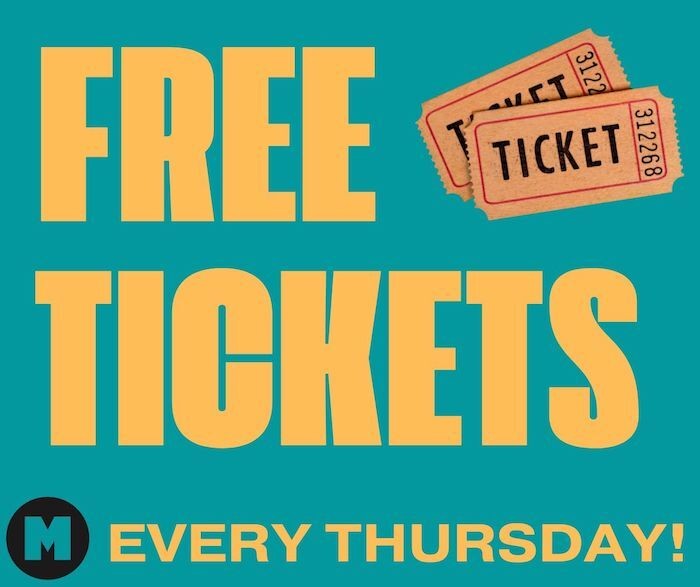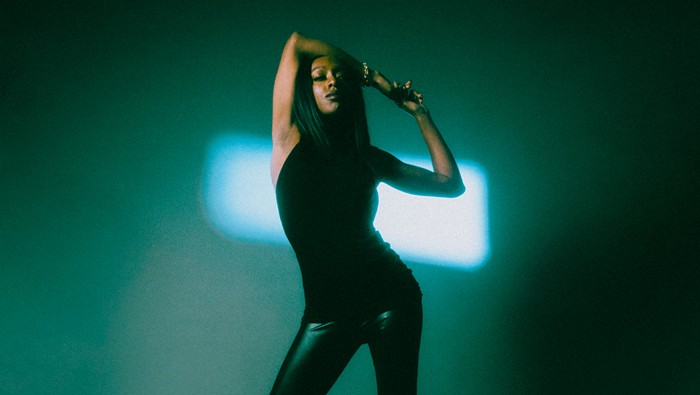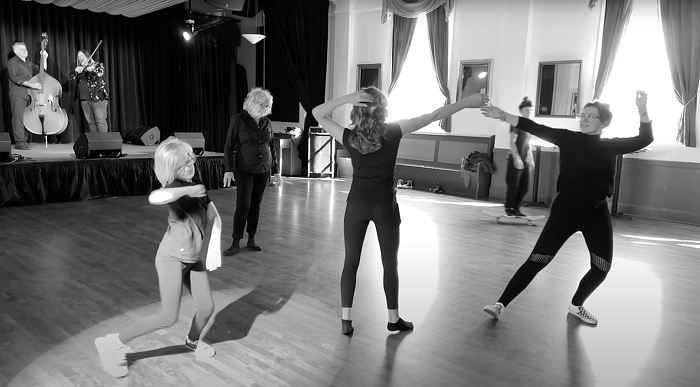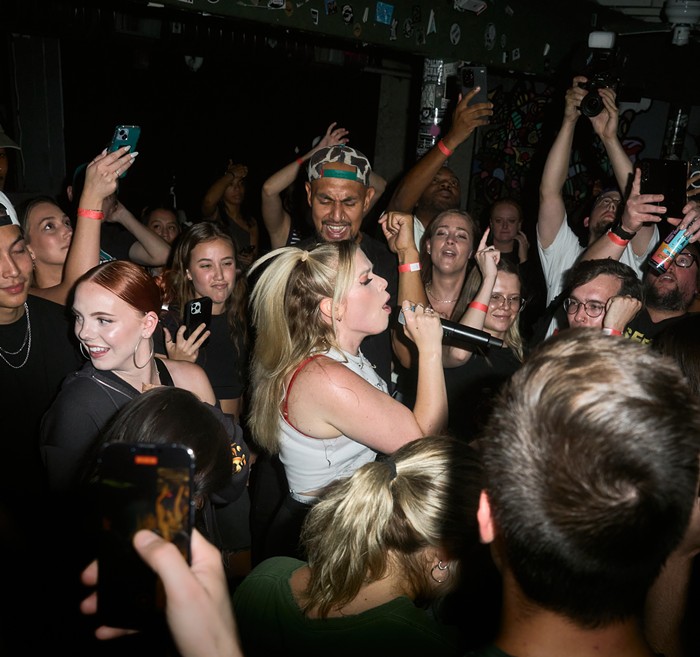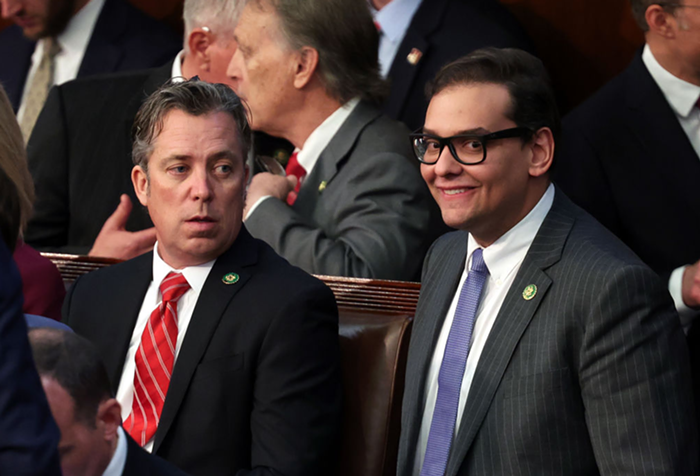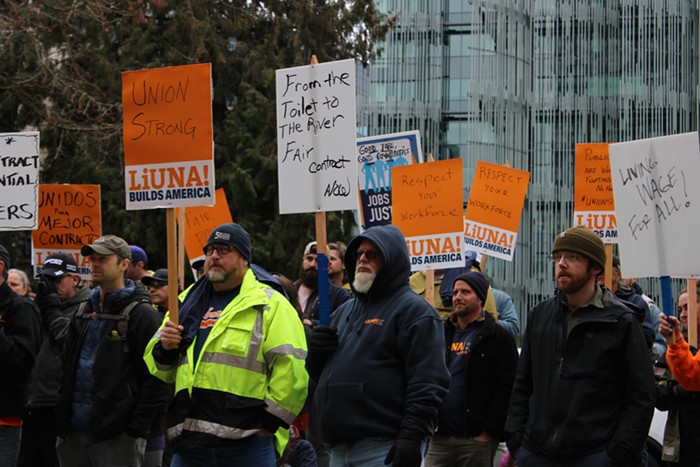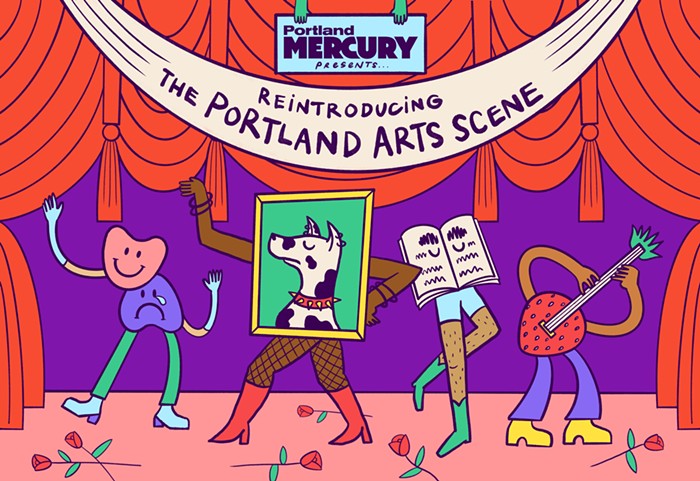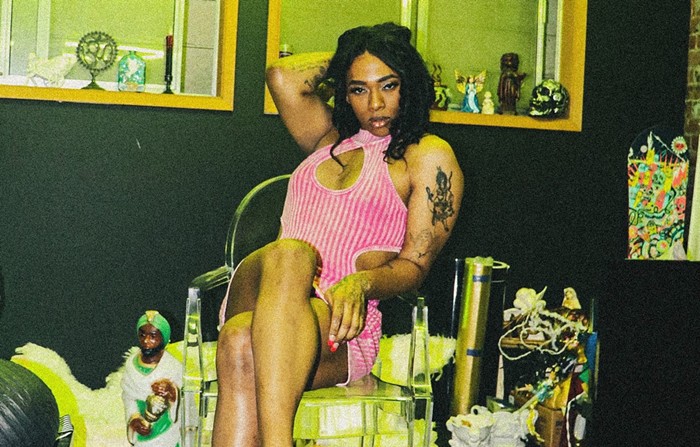Mythologizing the 1990s via that decade’s cultural touchstones has become something of a cottage industry. It’s given us reboots of Will & Grace and Roseanne, Pretty Woman: The Musical, and the “Summerland Tour,” an annual touring festival (usually headlined by Everclear) that stopped at the Crystal Ballroom in June.
While many of those ventures seem like cash-grab nostalgia, some recent glances in the rearview mirror have provided more context and appreciation for how dramatically the music world shifted during that decade. Spurred by the huge success of Nirvana’s 1991 sophomore album Nevermind, the mass media finally began to take the underground rock scene seriously. Major labels started snapping up young bands by the dozens, and many indie imprints were financially buoyed as a new generation of listeners sought out the guitar squalls and tortured poetics of skinny young men in thrift store T-shirts.
This cultural churn sparked the fire that, more than two decades later, is still smoldering and giving off plenty of heat. Key to all this were the efforts of tastemakers looking for the next hotbed of musical activity in a city that wasn’t New York or Los Angeles. The spotlight spun around North America and landed on places like Chapel Hill, Montreal, and the DC area. And for the first time in what would soon become a constant cycle, attention turned toward what was happening in Portland.
The city had produced several pop successes with the likes of Nu Shooz, Quarterflash, and the U-Krew scoring chart hits. And there were some buzzed-about underground acts like the Wipers, Dead Moon, and Poison Idea. But it wasn’t until the early ’90s that the world started to look at Portland as having, as Spin magazine writer Grant Alden put it in a profile on local trio Pond, “the raw meat (or vegetables) alternative music relentlessly seems to feed on nowadays: a genuine, bona fide scene.”
For good or ill, what Alden highlighted in 1993 set the table for the next 25 years of creative culture in Portland. Those golden years helped bolster the city’s unkempt, often shoddily managed venues and record labels, and fed the growth of bands and artists that made even the most hyped “alternative” acts seem stuffy and stiff in comparison. Portland’s current crop of musicians built upon a foundation of handcrafted weirdness and cockeyed artistic expression to find mainstream success, or at least enough attention to keep the home fires burning.
At that time, all the basic materials necessary to build an exciting underground music community were readily available. Portland was dotted with venues like the X-Ray Cafe and Satyricon, where young bands could play their first shows, hone their abilities, and build an audience. A healthy amount of record labels, including Schizophonic and Tim/Kerr Records, documented the sounds of the city. And, perhaps most importantly, young artists could afford to concentrate on their music because it was so damn cheap to live here.
“We moved there in the summer of ’91, right after college,” remembers Neil Gust, who co-founded the melodic rock band Heatmiser with Elliott Smith. “I lived in a house that was, like, 800 bucks for four people. And it was a whole house. That’s where we rehearsed. All our friends worked at coffee shops or restaurants or bars. If you played in a band, you had something to trade. You could get people into shows and then you could drink coffee or beer for free. It was like a currency.”
All of that allowed a fantastically varied scene to start bubbling under and boiling over. In addition to the psych-skronk of Pond and Heatmiser’s impassioned expressions of personal agony, a diverse batch of guitar-based bands grew from this fertile soil, as well as a wealth of outliers like the noise-funk of Hitting Birth, the industrial grinding of Anal Solvent and Daniel Menche, a smattering of heavy rock (Drunk at Abi’s, Iommi Stubbs), and the thriving jazz, blues, and roots music rabble.
What helped crack the Portland scene open to an international audience was the help of some of the best indie labels on the West Coast. As groups like Dharma Bums and Crackerbash became emboldened enough to start touring into Washington and through California, they started to attract the attention of imprints like LA’s Frontier Records and Seattle’s Empty Records, respectively.
“It was exciting to have anyone who cared,” says Sean Croghan, the singer/guitarist for Crackerbash, who released two albums via Empty. “Suddenly, we were getting to do things that before would have been seemingly impossible. None of us were good organizers, so we weren’t good at booking our own tours and stuff like that. Now we had people to help us go to LA and go to the East Coast and then go to Europe. That was all because of Empty. Because they believed in us.”
The label that had the biggest impact on Portland was Sub Pop Records. The Seattle-based company was, by the early ’90s, considered by the mass media to be the arbiters of all things cool in the grunge era, having shepherded blue-chip acts Nirvana and the Afghan Whigs into major-label success. The label’s co-owners Jonathan Poneman and Bruce Pavitt managed to keep a level, and often sardonic, head about the whole thing. Their interest in seeking out interesting new sounds never diminished, like the evening that Poneman visited Portland in 1992 and stumbled upon Sprinkler playing at the X-Ray Cafe. Immediately taken with what he heard, he snagged the band’s leader Chris Slusarenko after the gig.
“We got done and there was this guy hanging around. He was like, ‘Who are you recording for?’” says Slusarenko. “Recording for? That seemed completely abstract to me. Poison Idea did it. The Miracle Workers did it. And they seemed like gods. They were chosen to put out records. I didn’t know you could do it yourself. I told him ‘No one,’ and he’s like, ‘Oh, give me a call,’ and hands me this Sub Pop business card. My mind split open. ‘Sub Pop? Really? Us?’”

Listening to Sprinkler’s 1992 full-length More Boy, Less Friend now, it’s not difficult to understand what caught Poneman’s attention. The band’s meaty, fuzzy sound and Slusarenko’s strained yelp were birthed from the same pool of classic rock and punk influences that had spawned many of the acts on Sub Pop’s roster at the time.
Soon the label quickly snapped up three other Portland acts: Pond, the pop/punk-leaning quartet Hazel, and the Spinanes, a guitar-and-drums duo that played with a crisp efficiency. Within months, all four had released equally amazing debuts bearing the familiar black-and-white Sub Pop logo, and were crisscrossing North America and Europe on tour. Along the way, the bands landed press notices in Rolling Stone and CMJ, as well as bigger opportunities, like Sprinkler opening for Nirvana at their first big post-Nevermind gigs, Pond recording a session for BBC Radio, and the Spinanes filming both a performance for Late Night with Conan O’Brien and a substantial feature for MTV News.
“I once had to list every venue I played in New York for someone that doesn’t live there,” says Rebecca Gates, laughing as she remembers her days on the road with her band the Spinanes. “We toured for nine months after Manos [the duo’s 1993 debut] came out. We did some dates with Red Red Meat. We ended up touring Europe with Codeine for six weeks. We did a run with the Poster Children, a West Coast tour with Superchunk, and the Afghan Whigs tour was the biggest official thing we did. That was the full country in the spring of ’94.” For their indefatigable efforts, Manos became the first independently released album to land in the top spot of the college radio charts.
Sub Pop could have had an even bigger impact here, had Poneman not balked at the idea of signing more Portland acts, which he now chalks up to being “young and foolish.”
“I became familiar with other bands like Dharma Bums, whose manager at the time was Rebecca Gates,” remembers Poneman. “And Charlie Campbell of Pond was a big advocate for a lot of the Portland bands. One of whom was Heatmiser, whose demo I really liked a lot. But, you know, we signed three Portland bands relatively quickly, and I was fearing, in my stupid self-consciousness, that people would read it as being a ‘Seattle scene, only this time it’s Portland’ sort of thing.”
For all his regrets, that was a fair prediction of how the mainstream press would have assessed things. But it wasn’t hard to see that something significant was going down in Portland. La Luna, the premiere venue for mid-level indie bands of the time, would regularly sell out their inexpensive showcases for local music. And self-booked, self-promoted parties that artists like Hitting Birth and Cool Nutz were putting together often drew healthy, excited crowds. Mostly, there was camaraderie among the disparate folks in the music scene, a supportive feeling that looked upon any artist breaking out on a national level, even in a minor way, as a victory for the city as a whole.
“I felt incredibly proud of the Portland scene,” says Jeremy Wilson, the singer/guitarist who fronted Dharma Bums from 1987 until their split in 1992. “I felt absolutely like we were going to change the world. That was the energy that was fueling me, at least. I look back on that with a little bit of a shirk [sic], realizing how naive I was in some ways. At the same time, that youthful mindset that you could change the world with music was a really unique thing.”
“I felt incredibly proud of the Portland scene,” says Jeremy Wilson. “I felt absolutely like we were going to change the world. That was the energy that was fueling me, at least. That youthful mindset that you could change the world with music was a really unique thing.”
The philosophy for booking shows also wasn’t as codified and narrow as it tends to be now. Bands of all stripes shared stages together, recognizing and appreciating their individual goals and sounds, even if they didn’t necessarily jibe.
“We’d play shows with Hitting Birth and Drunk at Abi’s or more industrial-type groups,” says Croghan. “That was part of the smallness of the city. There weren’t enough people to really go, ‘Okay, we’re exclusively into this kind of music,’ and there’ll be a rockabilly scene and a noise scene and a punk/pop scene. No, you’d play with each other and support each other. There were amazing shows that happened around that time because of it.”
If there is a central source for Portland’s music community in the ’90s, it was likely the X-Ray Cafe. The lifespan of this all-ages venue was short—from 1990 to 1994—but those four years fomented much of the “weird” spirit that has slowly started to melt out of the city, no matter how much the bumper stickers plead with us.
Run by buddies and bandmates Tres Shannon and Ben Ellis, the downtown space had a loose, welcoming booking policy. Local artists like Menche, Heatmiser, and Quasi, along with a number of now-well-known out-of-town acts like Green Day and Hole, may have eventually graduated to bigger spaces like Satyricon, Berbati’s Pan, and La Luna, but their first Portland shows were at the X-Ray. And scheduled in and around those concerts were loosely organized events like pajama parties, Spanish lessons, and sewing circles.
“They could have the most ridiculous shit going on there,” remembers Pete Miser, the hip-hop artist who made his name as the MC for the Five Fingers of Funk. “I remember there was the Kinko’s Battle of the Bands, where every band had to have at least one member who was an employee of Kinko’s. There were like, nine bands!”
X Ray Visions: A Look Inside Portland's Legendary X Ray Cafe from Microcosm Publishing on Vimeo.
Shannon, nowadays the owner of the massively successful Voodoo Doughnuts empire, mostly shrugs away any talk of the importance of the X-Ray Cafe, claiming that he and Ellis were simply lucky.
“Yeah, we obviously did some cool stuff,” he says, “but then I think it was just really the perfect time and a perfect place, and it occurred very organically. It’s always been a freaky town way before I moved here and way before the X-Ray. We just felt that kids should be able to see music, and liquor shouldn’t be the reason that kids can’t see bands.”
If there’s any big downside to the rise in Portland’s musical profile in the ’90s, it’s that the attention tended to favor rock bands made up primarily of white dudes. There were notable exceptions like the Spinanes, Team Dresch (the punk group featuring Hazel’s drummer Jody Bleyle), and the queercore trio the Third Sex, but as ever, the scales tipped toward pale, thin young men with guitars.

The most especially dismaying aspect was that the local hip-hop scene got very little shine outside of the city, even during a time when rap was the only musical commodity that rivaled alternative rock in terms of cultural impact.
For Portland, a huge factor was the relatively small size of the hip-hop community. The U-Krew, an ensemble that started in the mid-’80s, found some success with a pair of Billboard-charting singles. It just didn’t translate into A&R execs flying to the city to try and find the next big rap artist. Nor did it seem to inspire a swell of MCs trying to follow their lead and try and hit the big time.
“It wasn’t like the commerce part. It was more like the culture,” says Terrance Scott, the artist who records and performs as Cool Nutz and started the label Jus’ Family in 1992. “Everybody wasn’t putting out records. You knew who rapped. You knew who was breakdancing. You knew who was DJing. It was living the culture. There wasn’t really a demonstration of how to do business.”
The concentration at the time was on live performance. Scott and fellow MCs like Lifesavas, Mic Crenshaw, and Kenny Mack, as well as DJs like DJ OG One and DJ Chill, built their scene at park jams, house parties, and talent shows, graduating eventually to nights at clubs around the city as they gained momentum.
“It wasn’t like the commerce part. It was more like the culture,” says Terrance Scott. “Everybody wasn’t putting out records. You knew who rapped. You knew who was breakdancing. You knew who was DJing. It was living the culture. There wasn’t really a demonstration of how to do business.”
“We were putting 1,000 people in La Luna for local hip-hop shows,” Scott says. “Five hundred people in Berbati’s. Or the Five Fingers of Funk selling out the Roseland or selling out Berbati’s multiple nights. Seattle was able to capitalize on the internet better than we were. But we were able to capitalize on bringing people out. Selling hard tickets and putting numbers in buildings.”
In the ’90s, that energy tended to stay within the Portland metro area. For a while, that was enough, but as the profile of the hip-hop scene has been raised by the recent success of Aminé and the Last Artful, Dodgr, Scott hopes those artists won’t forget where they came from.
“I feel like when you get a certain spotlight,” he says, “you should also be mindful of what you can put back into the city to help put it in the position to grow. I feel like Macklemore did a really good job of that for Seattle. When we started doing some of the stuff that we were doing early on, a big part of that was showing the city that Portland has a hip-hop scene.”
Idealizing what went on in the Portland music scene two decades ago feels a little foolish, especially in light of all the amazing things that have happened since. We’ve seen dozens of our native sons and daughters like Elliott Smith, Sleater-Kinney, and the Decemberists become international successes. An equal number of micro-scenes have grown up around the city with experimental artists, electronic music, punk, metal, and R&B getting deserved attention. And we’ve seen a decent number of musicians relocating here to take advantage of the liberal politics, legal weed, and other amenities that have launched a thousand think-pieces and listicles.
But what’s more important is what’s gotten lost along the way. Being able to survive as a working artist in the city is harder than ever, thanks to exponential increases in the cost of living. There are few comparable all-ages venues like the X-Ray Cafe or La Luna attempting to open their doors to new bands and young listeners. And with so many other musicians living in Portland and so few access points, it’s often harder to get heard.
“There’s just so much more, and now you have to be so much better to get any kind of attention,” says Croghan. “I mean [Crackerbash] weren’t great and we got a ton of attention. I’m not slighting us, but I think if we were to come around now, I would have to become a better musician and a better songwriter because there are so many bands.”
The wealth of new music and the deluge of sounds available with a few taps on our phones also has had the troubling result that many of Portland’s foundational musicians and history are getting ignored or forgotten about. Morgan Troper’s recent Mercury feature [“So You Are a Star? Okay,” Feature, Aug 8] cites how the pop successes of Quarterflash and Nu Shooz are often swept aside when the history of local music gets written.
Of the artists I spoke with for this article, the ones who are still living here and making music don’t seem too troubled by that. Only one wondered aloud why it’s so difficult to get a show at Mississippi Studios or the Doug Fir. But beyond that small complaint, everyone seems secure in what they accomplished in their younger days and where they are now.
“It was definitely a fun time in my life,” says Chris Brady, bassist and vocalist for Pond. “I had a blast. It was a great way to spend my 20s. I got to play with some of my favorite bands. Got to see America and Europe and a lot of Canada a couple of times. It’s hard to think back sometimes. It’s definitely a golden moment for my life. Or, you know, one day I was walking and someone was playing our song ‘Van’ from their car. And it went by and this weird little tendril of an old memory came up: ‘Oh that’s my band! That was 20 years ago!’”
